Operations and Project Management Report - Lindos Electronics Analysis
VerifiedAdded on 2020/06/05
|12
|3957
|90
Report
AI Summary
This report delves into the critical aspects of operations and project management, focusing on the application of these principles within the context of Lindos Electronics, a UK-based company. Part A explores the implementation of operations management principles, emphasizing continuous improvement plans, the Six Sigma methodology, and Lean principles to enhance efficiency. The report analyzes strategies for continuous improvement, including the Plan-Do-Check-Act model and the integration of Lean and Six Sigma methodologies. Part B shifts focus to project management, outlining the stages of a project life cycle, its effectiveness, and the methodologies, tools, and leadership involved. It further differentiates project life cycles in small and large-scale projects and provides a critical evaluation of the project life cycle. The report highlights the importance of adapting to market dynamics and utilizing customer segmentation strategies to drive business growth and profitability, offering a comprehensive analysis of operational and project management strategies for business development.
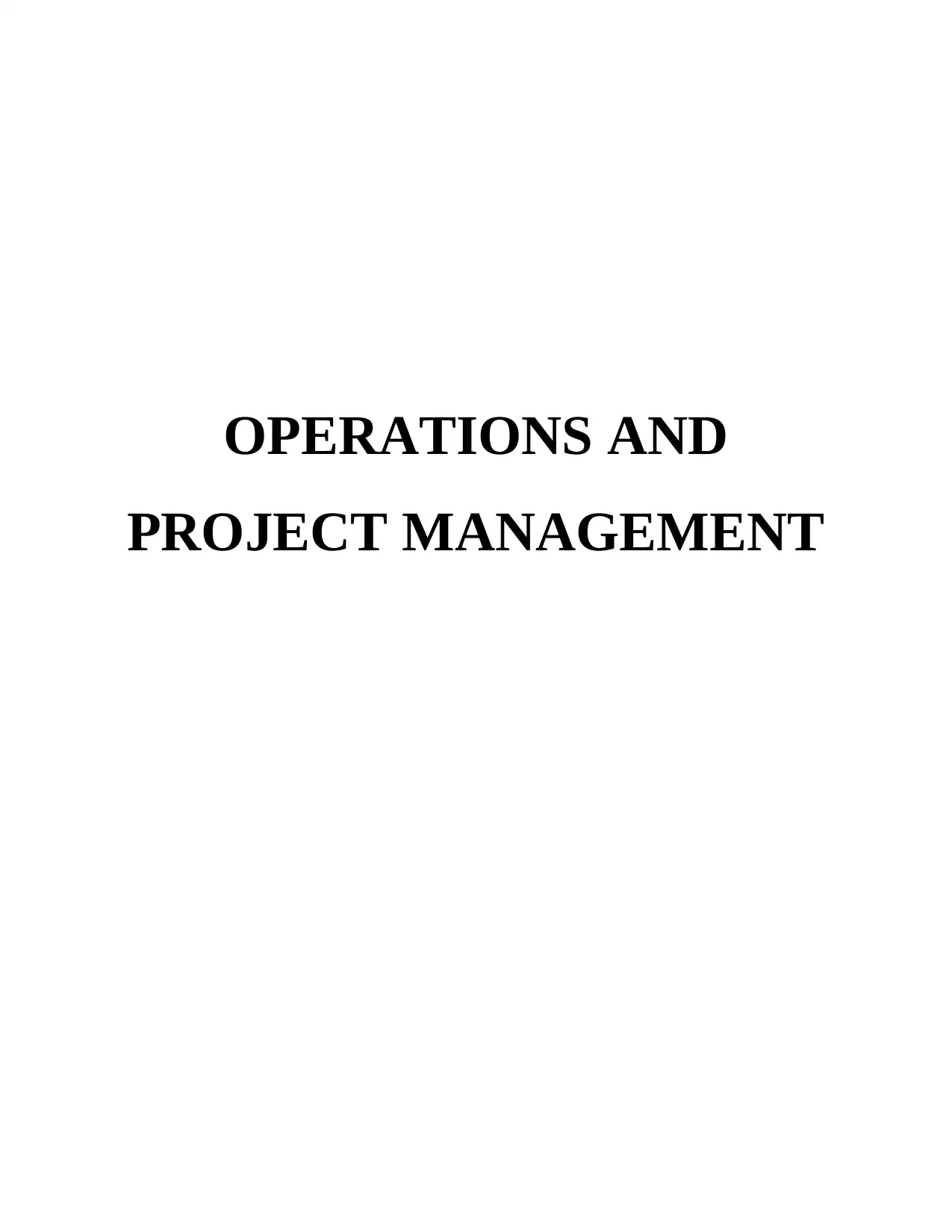
OPERATIONS AND
PROJECT MANAGEMENT
PROJECT MANAGEMENT
Paraphrase This Document
Need a fresh take? Get an instant paraphrase of this document with our AI Paraphraser
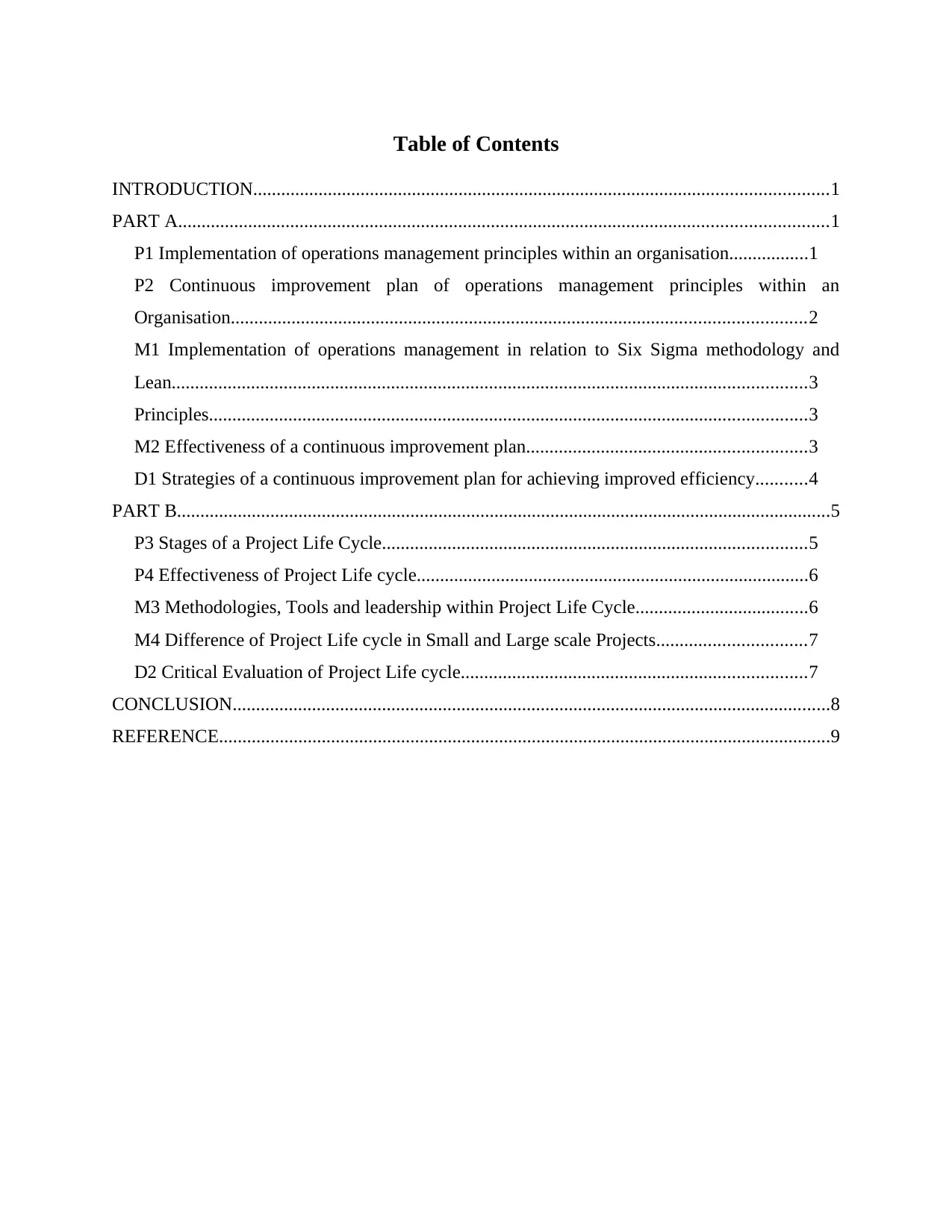
Table of Contents
INTRODUCTION...........................................................................................................................1
PART A...........................................................................................................................................1
P1 Implementation of operations management principles within an organisation.................1
P2 Continuous improvement plan of operations management principles within an
Organisation...........................................................................................................................2
M1 Implementation of operations management in relation to Six Sigma methodology and
Lean........................................................................................................................................3
Principles................................................................................................................................3
M2 Effectiveness of a continuous improvement plan............................................................3
D1 Strategies of a continuous improvement plan for achieving improved efficiency...........4
PART B............................................................................................................................................5
P3 Stages of a Project Life Cycle...........................................................................................5
P4 Effectiveness of Project Life cycle....................................................................................6
M3 Methodologies, Tools and leadership within Project Life Cycle.....................................6
M4 Difference of Project Life cycle in Small and Large scale Projects................................7
D2 Critical Evaluation of Project Life cycle..........................................................................7
CONCLUSION................................................................................................................................8
REFERENCE...................................................................................................................................9
INTRODUCTION...........................................................................................................................1
PART A...........................................................................................................................................1
P1 Implementation of operations management principles within an organisation.................1
P2 Continuous improvement plan of operations management principles within an
Organisation...........................................................................................................................2
M1 Implementation of operations management in relation to Six Sigma methodology and
Lean........................................................................................................................................3
Principles................................................................................................................................3
M2 Effectiveness of a continuous improvement plan............................................................3
D1 Strategies of a continuous improvement plan for achieving improved efficiency...........4
PART B............................................................................................................................................5
P3 Stages of a Project Life Cycle...........................................................................................5
P4 Effectiveness of Project Life cycle....................................................................................6
M3 Methodologies, Tools and leadership within Project Life Cycle.....................................6
M4 Difference of Project Life cycle in Small and Large scale Projects................................7
D2 Critical Evaluation of Project Life cycle..........................................................................7
CONCLUSION................................................................................................................................8
REFERENCE...................................................................................................................................9
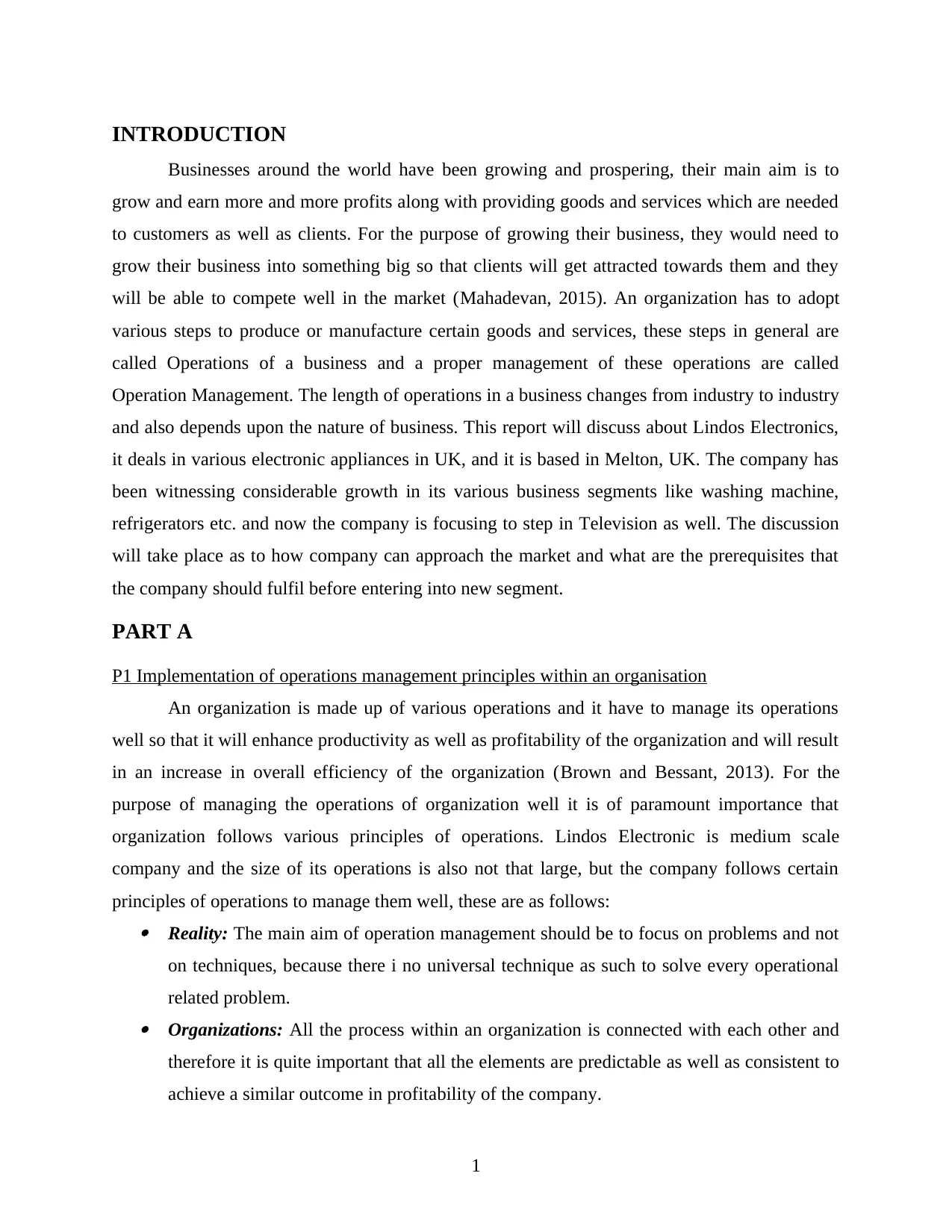
INTRODUCTION
Businesses around the world have been growing and prospering, their main aim is to
grow and earn more and more profits along with providing goods and services which are needed
to customers as well as clients. For the purpose of growing their business, they would need to
grow their business into something big so that clients will get attracted towards them and they
will be able to compete well in the market (Mahadevan, 2015). An organization has to adopt
various steps to produce or manufacture certain goods and services, these steps in general are
called Operations of a business and a proper management of these operations are called
Operation Management. The length of operations in a business changes from industry to industry
and also depends upon the nature of business. This report will discuss about Lindos Electronics,
it deals in various electronic appliances in UK, and it is based in Melton, UK. The company has
been witnessing considerable growth in its various business segments like washing machine,
refrigerators etc. and now the company is focusing to step in Television as well. The discussion
will take place as to how company can approach the market and what are the prerequisites that
the company should fulfil before entering into new segment.
PART A
P1 Implementation of operations management principles within an organisation
An organization is made up of various operations and it have to manage its operations
well so that it will enhance productivity as well as profitability of the organization and will result
in an increase in overall efficiency of the organization (Brown and Bessant, 2013). For the
purpose of managing the operations of organization well it is of paramount importance that
organization follows various principles of operations. Lindos Electronic is medium scale
company and the size of its operations is also not that large, but the company follows certain
principles of operations to manage them well, these are as follows: Reality: The main aim of operation management should be to focus on problems and not
on techniques, because there i no universal technique as such to solve every operational
related problem. Organizations: All the process within an organization is connected with each other and
therefore it is quite important that all the elements are predictable as well as consistent to
achieve a similar outcome in profitability of the company.
1
Businesses around the world have been growing and prospering, their main aim is to
grow and earn more and more profits along with providing goods and services which are needed
to customers as well as clients. For the purpose of growing their business, they would need to
grow their business into something big so that clients will get attracted towards them and they
will be able to compete well in the market (Mahadevan, 2015). An organization has to adopt
various steps to produce or manufacture certain goods and services, these steps in general are
called Operations of a business and a proper management of these operations are called
Operation Management. The length of operations in a business changes from industry to industry
and also depends upon the nature of business. This report will discuss about Lindos Electronics,
it deals in various electronic appliances in UK, and it is based in Melton, UK. The company has
been witnessing considerable growth in its various business segments like washing machine,
refrigerators etc. and now the company is focusing to step in Television as well. The discussion
will take place as to how company can approach the market and what are the prerequisites that
the company should fulfil before entering into new segment.
PART A
P1 Implementation of operations management principles within an organisation
An organization is made up of various operations and it have to manage its operations
well so that it will enhance productivity as well as profitability of the organization and will result
in an increase in overall efficiency of the organization (Brown and Bessant, 2013). For the
purpose of managing the operations of organization well it is of paramount importance that
organization follows various principles of operations. Lindos Electronic is medium scale
company and the size of its operations is also not that large, but the company follows certain
principles of operations to manage them well, these are as follows: Reality: The main aim of operation management should be to focus on problems and not
on techniques, because there i no universal technique as such to solve every operational
related problem. Organizations: All the process within an organization is connected with each other and
therefore it is quite important that all the elements are predictable as well as consistent to
achieve a similar outcome in profitability of the company.
1
⊘ This is a preview!⊘
Do you want full access?
Subscribe today to unlock all pages.

Trusted by 1+ million students worldwide
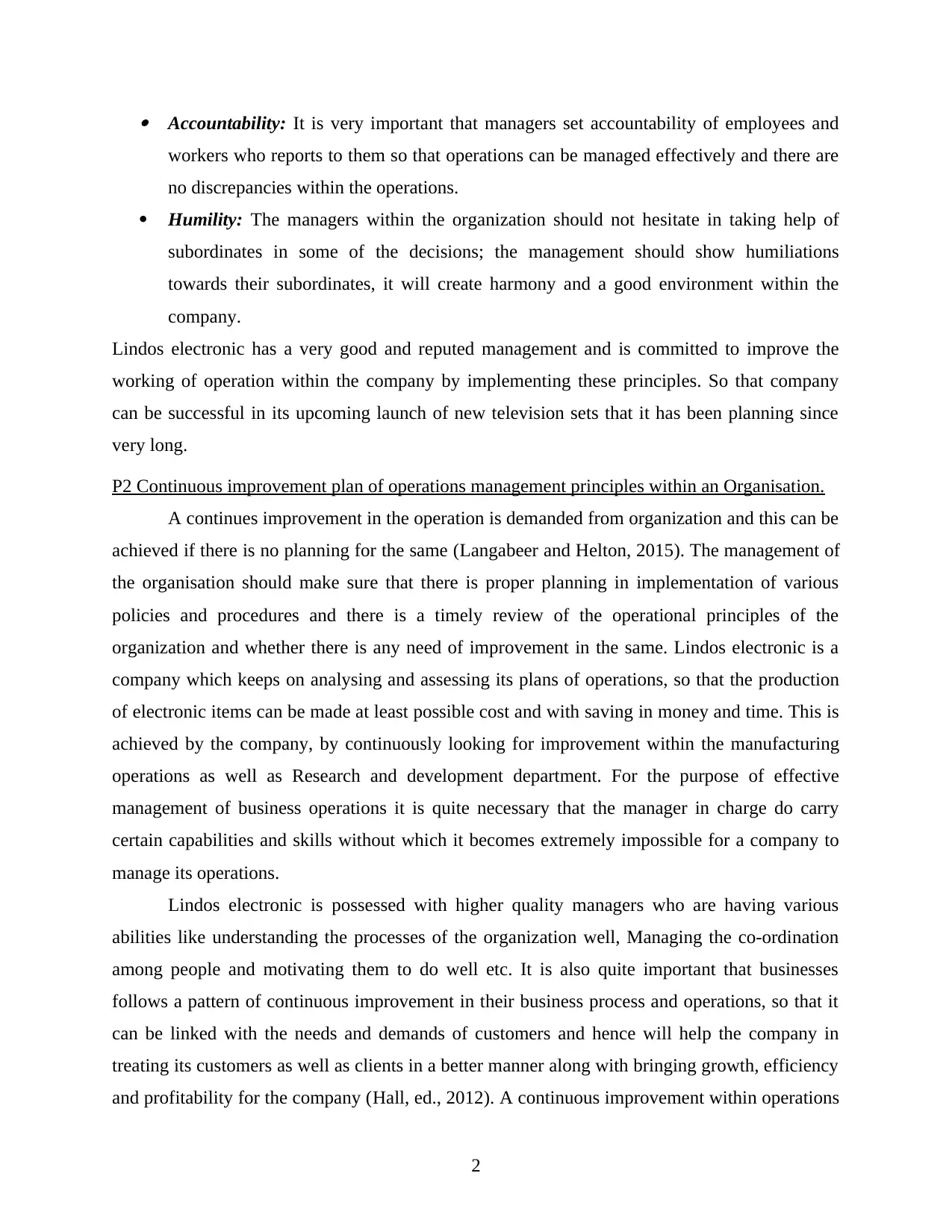
Accountability: It is very important that managers set accountability of employees and
workers who reports to them so that operations can be managed effectively and there are
no discrepancies within the operations.
Humility: The managers within the organization should not hesitate in taking help of
subordinates in some of the decisions; the management should show humiliations
towards their subordinates, it will create harmony and a good environment within the
company.
Lindos electronic has a very good and reputed management and is committed to improve the
working of operation within the company by implementing these principles. So that company
can be successful in its upcoming launch of new television sets that it has been planning since
very long.
P2 Continuous improvement plan of operations management principles within an Organisation.
A continues improvement in the operation is demanded from organization and this can be
achieved if there is no planning for the same (Langabeer and Helton, 2015). The management of
the organisation should make sure that there is proper planning in implementation of various
policies and procedures and there is a timely review of the operational principles of the
organization and whether there is any need of improvement in the same. Lindos electronic is a
company which keeps on analysing and assessing its plans of operations, so that the production
of electronic items can be made at least possible cost and with saving in money and time. This is
achieved by the company, by continuously looking for improvement within the manufacturing
operations as well as Research and development department. For the purpose of effective
management of business operations it is quite necessary that the manager in charge do carry
certain capabilities and skills without which it becomes extremely impossible for a company to
manage its operations.
Lindos electronic is possessed with higher quality managers who are having various
abilities like understanding the processes of the organization well, Managing the co-ordination
among people and motivating them to do well etc. It is also quite important that businesses
follows a pattern of continuous improvement in their business process and operations, so that it
can be linked with the needs and demands of customers and hence will help the company in
treating its customers as well as clients in a better manner along with bringing growth, efficiency
and profitability for the company (Hall, ed., 2012). A continuous improvement within operations
2
workers who reports to them so that operations can be managed effectively and there are
no discrepancies within the operations.
Humility: The managers within the organization should not hesitate in taking help of
subordinates in some of the decisions; the management should show humiliations
towards their subordinates, it will create harmony and a good environment within the
company.
Lindos electronic has a very good and reputed management and is committed to improve the
working of operation within the company by implementing these principles. So that company
can be successful in its upcoming launch of new television sets that it has been planning since
very long.
P2 Continuous improvement plan of operations management principles within an Organisation.
A continues improvement in the operation is demanded from organization and this can be
achieved if there is no planning for the same (Langabeer and Helton, 2015). The management of
the organisation should make sure that there is proper planning in implementation of various
policies and procedures and there is a timely review of the operational principles of the
organization and whether there is any need of improvement in the same. Lindos electronic is a
company which keeps on analysing and assessing its plans of operations, so that the production
of electronic items can be made at least possible cost and with saving in money and time. This is
achieved by the company, by continuously looking for improvement within the manufacturing
operations as well as Research and development department. For the purpose of effective
management of business operations it is quite necessary that the manager in charge do carry
certain capabilities and skills without which it becomes extremely impossible for a company to
manage its operations.
Lindos electronic is possessed with higher quality managers who are having various
abilities like understanding the processes of the organization well, Managing the co-ordination
among people and motivating them to do well etc. It is also quite important that businesses
follows a pattern of continuous improvement in their business process and operations, so that it
can be linked with the needs and demands of customers and hence will help the company in
treating its customers as well as clients in a better manner along with bringing growth, efficiency
and profitability for the company (Hall, ed., 2012). A continuous improvement within operations
2
Paraphrase This Document
Need a fresh take? Get an instant paraphrase of this document with our AI Paraphraser
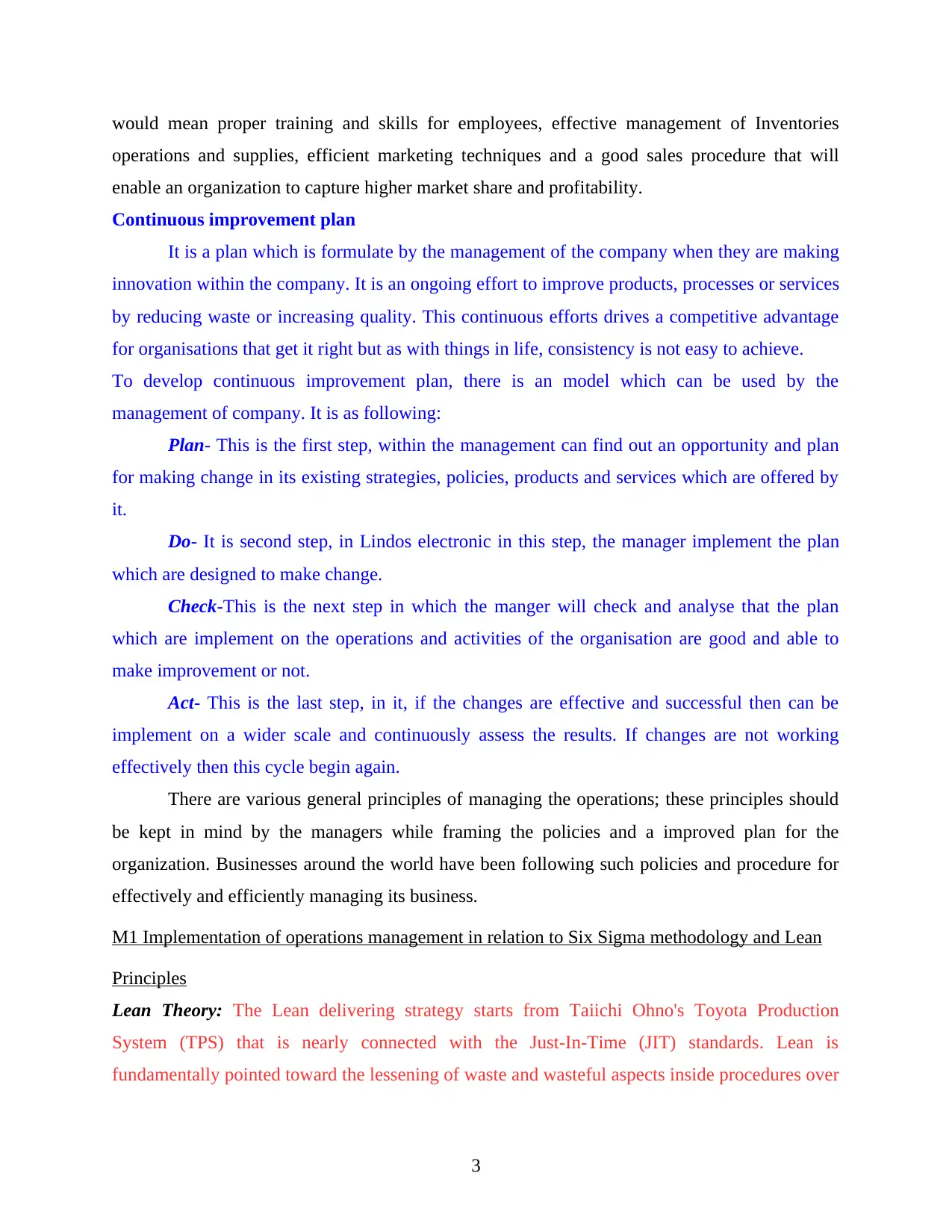
would mean proper training and skills for employees, effective management of Inventories
operations and supplies, efficient marketing techniques and a good sales procedure that will
enable an organization to capture higher market share and profitability.
Continuous improvement plan
It is a plan which is formulate by the management of the company when they are making
innovation within the company. It is an ongoing effort to improve products, processes or services
by reducing waste or increasing quality. This continuous efforts drives a competitive advantage
for organisations that get it right but as with things in life, consistency is not easy to achieve.
To develop continuous improvement plan, there is an model which can be used by the
management of company. It is as following:
Plan- This is the first step, within the management can find out an opportunity and plan
for making change in its existing strategies, policies, products and services which are offered by
it.
Do- It is second step, in Lindos electronic in this step, the manager implement the plan
which are designed to make change.
Check-This is the next step in which the manger will check and analyse that the plan
which are implement on the operations and activities of the organisation are good and able to
make improvement or not.
Act- This is the last step, in it, if the changes are effective and successful then can be
implement on a wider scale and continuously assess the results. If changes are not working
effectively then this cycle begin again.
There are various general principles of managing the operations; these principles should
be kept in mind by the managers while framing the policies and a improved plan for the
organization. Businesses around the world have been following such policies and procedure for
effectively and efficiently managing its business.
M1 Implementation of operations management in relation to Six Sigma methodology and Lean
Principles
Lean Theory: The Lean delivering strategy starts from Taiichi Ohno's Toyota Production
System (TPS) that is nearly connected with the Just-In-Time (JIT) standards. Lean is
fundamentally pointed toward the lessening of waste and wasteful aspects inside procedures over
3
operations and supplies, efficient marketing techniques and a good sales procedure that will
enable an organization to capture higher market share and profitability.
Continuous improvement plan
It is a plan which is formulate by the management of the company when they are making
innovation within the company. It is an ongoing effort to improve products, processes or services
by reducing waste or increasing quality. This continuous efforts drives a competitive advantage
for organisations that get it right but as with things in life, consistency is not easy to achieve.
To develop continuous improvement plan, there is an model which can be used by the
management of company. It is as following:
Plan- This is the first step, within the management can find out an opportunity and plan
for making change in its existing strategies, policies, products and services which are offered by
it.
Do- It is second step, in Lindos electronic in this step, the manager implement the plan
which are designed to make change.
Check-This is the next step in which the manger will check and analyse that the plan
which are implement on the operations and activities of the organisation are good and able to
make improvement or not.
Act- This is the last step, in it, if the changes are effective and successful then can be
implement on a wider scale and continuously assess the results. If changes are not working
effectively then this cycle begin again.
There are various general principles of managing the operations; these principles should
be kept in mind by the managers while framing the policies and a improved plan for the
organization. Businesses around the world have been following such policies and procedure for
effectively and efficiently managing its business.
M1 Implementation of operations management in relation to Six Sigma methodology and Lean
Principles
Lean Theory: The Lean delivering strategy starts from Taiichi Ohno's Toyota Production
System (TPS) that is nearly connected with the Just-In-Time (JIT) standards. Lean is
fundamentally pointed toward the lessening of waste and wasteful aspects inside procedures over
3
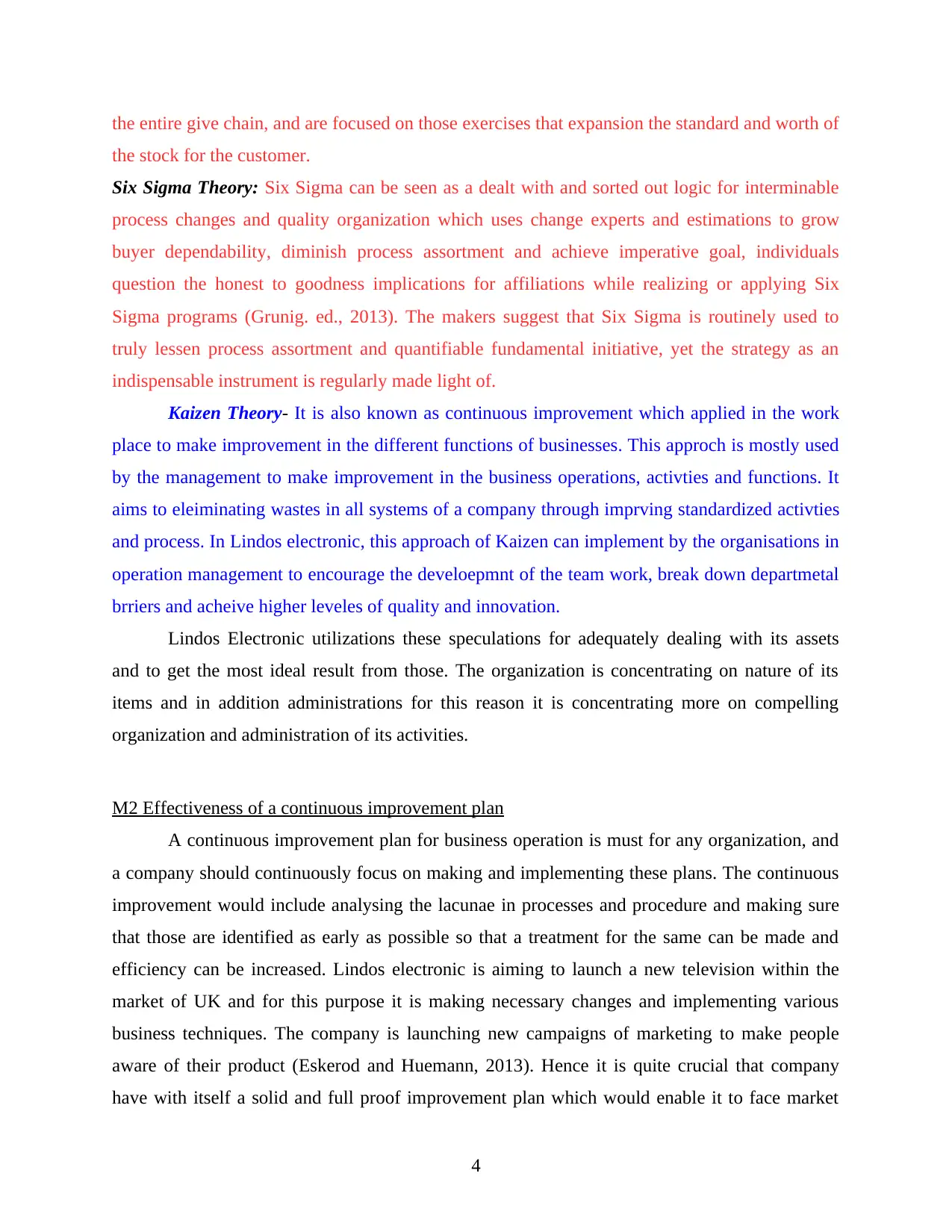
the entire give chain, and are focused on those exercises that expansion the standard and worth of
the stock for the customer.
Six Sigma Theory: Six Sigma can be seen as a dealt with and sorted out logic for interminable
process changes and quality organization which uses change experts and estimations to grow
buyer dependability, diminish process assortment and achieve imperative goal, individuals
question the honest to goodness implications for affiliations while realizing or applying Six
Sigma programs (Grunig. ed., 2013). The makers suggest that Six Sigma is routinely used to
truly lessen process assortment and quantifiable fundamental initiative, yet the strategy as an
indispensable instrument is regularly made light of.
Kaizen Theory- It is also known as continuous improvement which applied in the work
place to make improvement in the different functions of businesses. This approch is mostly used
by the management to make improvement in the business operations, activties and functions. It
aims to eleiminating wastes in all systems of a company through imprving standardized activties
and process. In Lindos electronic, this approach of Kaizen can implement by the organisations in
operation management to encourage the develoepmnt of the team work, break down departmetal
brriers and acheive higher leveles of quality and innovation.
Lindos Electronic utilizations these speculations for adequately dealing with its assets
and to get the most ideal result from those. The organization is concentrating on nature of its
items and in addition administrations for this reason it is concentrating more on compelling
organization and administration of its activities.
M2 Effectiveness of a continuous improvement plan
A continuous improvement plan for business operation is must for any organization, and
a company should continuously focus on making and implementing these plans. The continuous
improvement would include analysing the lacunae in processes and procedure and making sure
that those are identified as early as possible so that a treatment for the same can be made and
efficiency can be increased. Lindos electronic is aiming to launch a new television within the
market of UK and for this purpose it is making necessary changes and implementing various
business techniques. The company is launching new campaigns of marketing to make people
aware of their product (Eskerod and Huemann, 2013). Hence it is quite crucial that company
have with itself a solid and full proof improvement plan which would enable it to face market
4
the stock for the customer.
Six Sigma Theory: Six Sigma can be seen as a dealt with and sorted out logic for interminable
process changes and quality organization which uses change experts and estimations to grow
buyer dependability, diminish process assortment and achieve imperative goal, individuals
question the honest to goodness implications for affiliations while realizing or applying Six
Sigma programs (Grunig. ed., 2013). The makers suggest that Six Sigma is routinely used to
truly lessen process assortment and quantifiable fundamental initiative, yet the strategy as an
indispensable instrument is regularly made light of.
Kaizen Theory- It is also known as continuous improvement which applied in the work
place to make improvement in the different functions of businesses. This approch is mostly used
by the management to make improvement in the business operations, activties and functions. It
aims to eleiminating wastes in all systems of a company through imprving standardized activties
and process. In Lindos electronic, this approach of Kaizen can implement by the organisations in
operation management to encourage the develoepmnt of the team work, break down departmetal
brriers and acheive higher leveles of quality and innovation.
Lindos Electronic utilizations these speculations for adequately dealing with its assets
and to get the most ideal result from those. The organization is concentrating on nature of its
items and in addition administrations for this reason it is concentrating more on compelling
organization and administration of its activities.
M2 Effectiveness of a continuous improvement plan
A continuous improvement plan for business operation is must for any organization, and
a company should continuously focus on making and implementing these plans. The continuous
improvement would include analysing the lacunae in processes and procedure and making sure
that those are identified as early as possible so that a treatment for the same can be made and
efficiency can be increased. Lindos electronic is aiming to launch a new television within the
market of UK and for this purpose it is making necessary changes and implementing various
business techniques. The company is launching new campaigns of marketing to make people
aware of their product (Eskerod and Huemann, 2013). Hence it is quite crucial that company
have with itself a solid and full proof improvement plan which would enable it to face market
4
⊘ This is a preview!⊘
Do you want full access?
Subscribe today to unlock all pages.

Trusted by 1+ million students worldwide
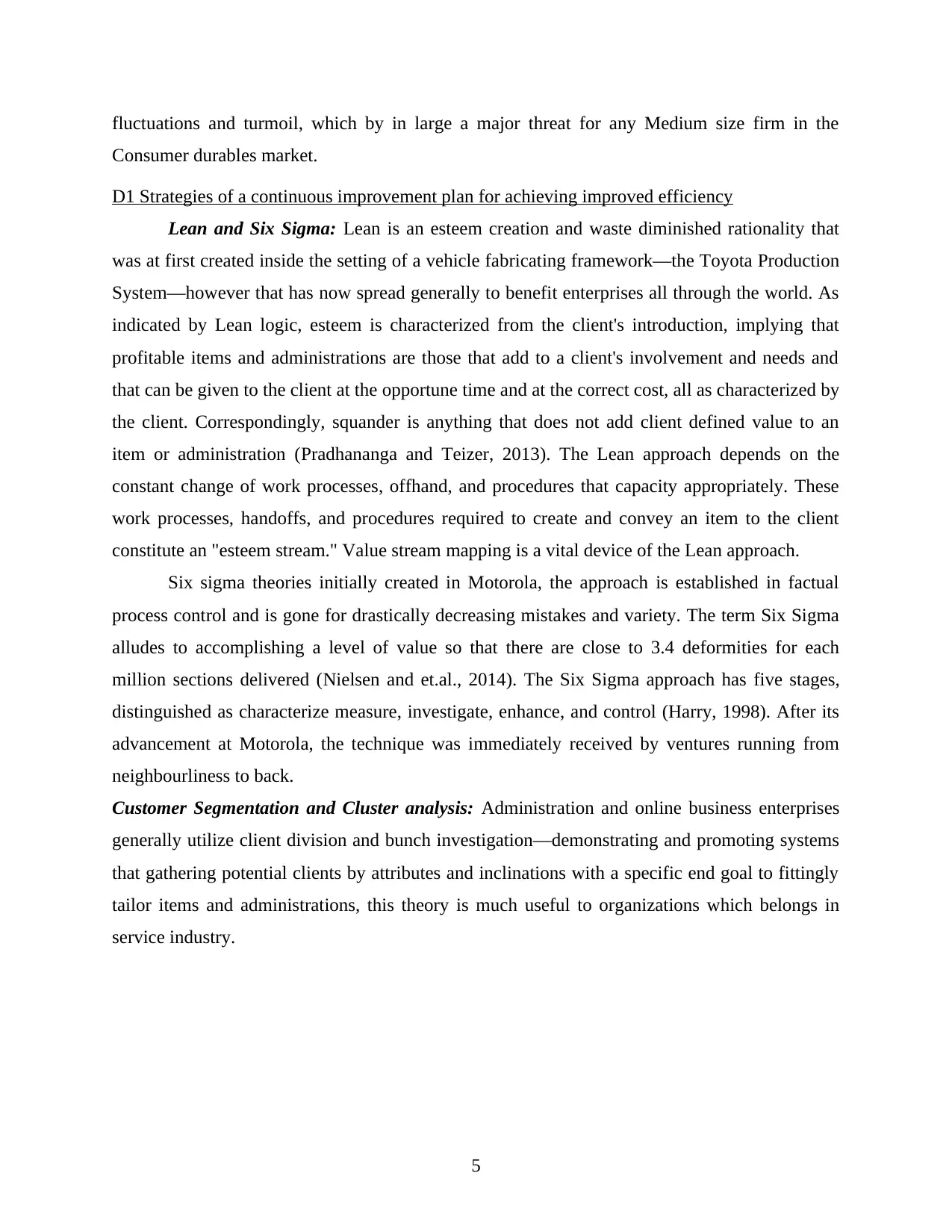
fluctuations and turmoil, which by in large a major threat for any Medium size firm in the
Consumer durables market.
D1 Strategies of a continuous improvement plan for achieving improved efficiency
Lean and Six Sigma: Lean is an esteem creation and waste diminished rationality that
was at first created inside the setting of a vehicle fabricating framework—the Toyota Production
System—however that has now spread generally to benefit enterprises all through the world. As
indicated by Lean logic, esteem is characterized from the client's introduction, implying that
profitable items and administrations are those that add to a client's involvement and needs and
that can be given to the client at the opportune time and at the correct cost, all as characterized by
the client. Correspondingly, squander is anything that does not add client defined value to an
item or administration (Pradhananga and Teizer, 2013). The Lean approach depends on the
constant change of work processes, offhand, and procedures that capacity appropriately. These
work processes, handoffs, and procedures required to create and convey an item to the client
constitute an "esteem stream." Value stream mapping is a vital device of the Lean approach.
Six sigma theories initially created in Motorola, the approach is established in factual
process control and is gone for drastically decreasing mistakes and variety. The term Six Sigma
alludes to accomplishing a level of value so that there are close to 3.4 deformities for each
million sections delivered (Nielsen and et.al., 2014). The Six Sigma approach has five stages,
distinguished as characterize measure, investigate, enhance, and control (Harry, 1998). After its
advancement at Motorola, the technique was immediately received by ventures running from
neighbourliness to back.
Customer Segmentation and Cluster analysis: Administration and online business enterprises
generally utilize client division and bunch investigation—demonstrating and promoting systems
that gathering potential clients by attributes and inclinations with a specific end goal to fittingly
tailor items and administrations, this theory is much useful to organizations which belongs in
service industry.
5
Consumer durables market.
D1 Strategies of a continuous improvement plan for achieving improved efficiency
Lean and Six Sigma: Lean is an esteem creation and waste diminished rationality that
was at first created inside the setting of a vehicle fabricating framework—the Toyota Production
System—however that has now spread generally to benefit enterprises all through the world. As
indicated by Lean logic, esteem is characterized from the client's introduction, implying that
profitable items and administrations are those that add to a client's involvement and needs and
that can be given to the client at the opportune time and at the correct cost, all as characterized by
the client. Correspondingly, squander is anything that does not add client defined value to an
item or administration (Pradhananga and Teizer, 2013). The Lean approach depends on the
constant change of work processes, offhand, and procedures that capacity appropriately. These
work processes, handoffs, and procedures required to create and convey an item to the client
constitute an "esteem stream." Value stream mapping is a vital device of the Lean approach.
Six sigma theories initially created in Motorola, the approach is established in factual
process control and is gone for drastically decreasing mistakes and variety. The term Six Sigma
alludes to accomplishing a level of value so that there are close to 3.4 deformities for each
million sections delivered (Nielsen and et.al., 2014). The Six Sigma approach has five stages,
distinguished as characterize measure, investigate, enhance, and control (Harry, 1998). After its
advancement at Motorola, the technique was immediately received by ventures running from
neighbourliness to back.
Customer Segmentation and Cluster analysis: Administration and online business enterprises
generally utilize client division and bunch investigation—demonstrating and promoting systems
that gathering potential clients by attributes and inclinations with a specific end goal to fittingly
tailor items and administrations, this theory is much useful to organizations which belongs in
service industry.
5
Paraphrase This Document
Need a fresh take? Get an instant paraphrase of this document with our AI Paraphraser
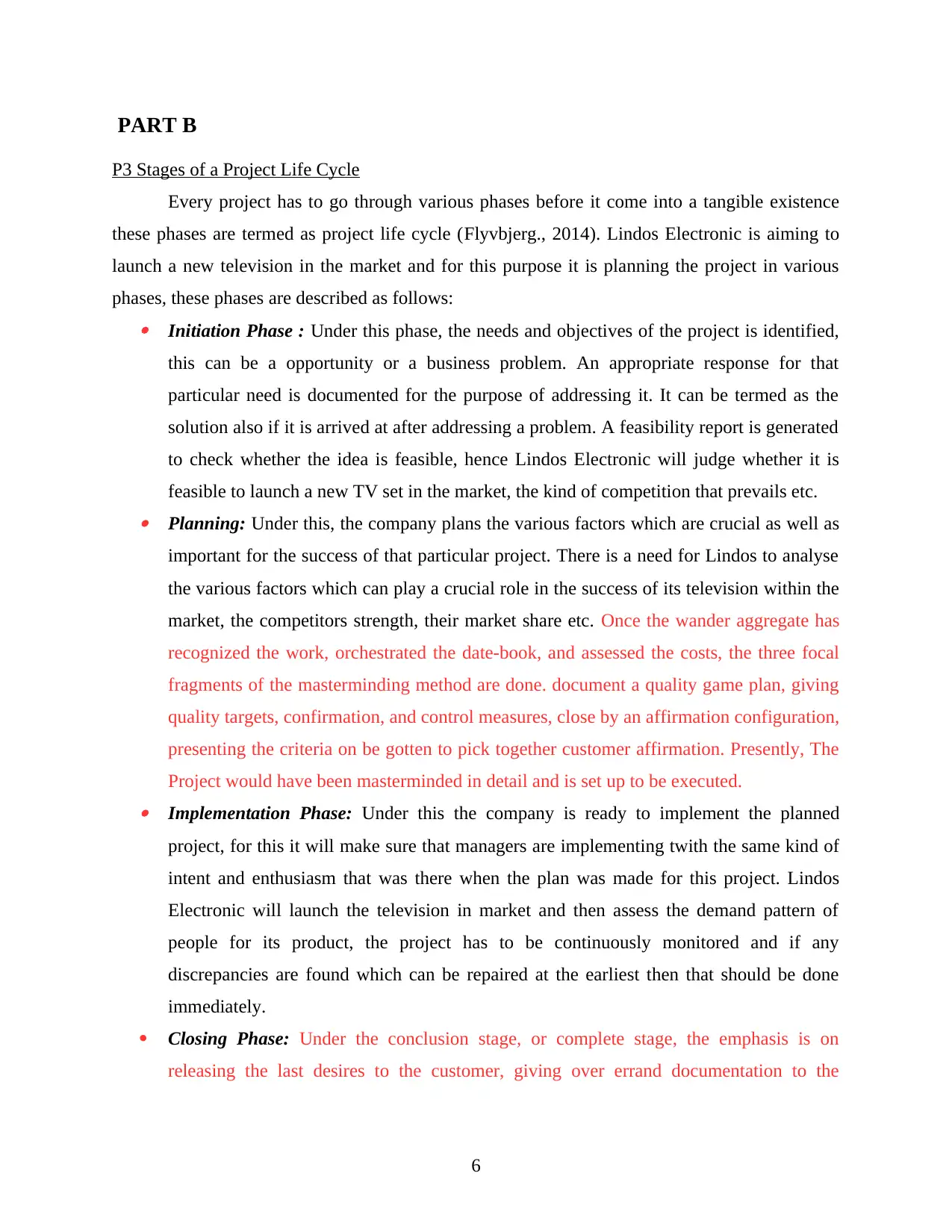
PART B
P3 Stages of a Project Life Cycle
Every project has to go through various phases before it come into a tangible existence
these phases are termed as project life cycle (Flyvbjerg., 2014). Lindos Electronic is aiming to
launch a new television in the market and for this purpose it is planning the project in various
phases, these phases are described as follows: Initiation Phase : Under this phase, the needs and objectives of the project is identified,
this can be a opportunity or a business problem. An appropriate response for that
particular need is documented for the purpose of addressing it. It can be termed as the
solution also if it is arrived at after addressing a problem. A feasibility report is generated
to check whether the idea is feasible, hence Lindos Electronic will judge whether it is
feasible to launch a new TV set in the market, the kind of competition that prevails etc. Planning: Under this, the company plans the various factors which are crucial as well as
important for the success of that particular project. There is a need for Lindos to analyse
the various factors which can play a crucial role in the success of its television within the
market, the competitors strength, their market share etc. Once the wander aggregate has
recognized the work, orchestrated the date-book, and assessed the costs, the three focal
fragments of the masterminding method are done. document a quality game plan, giving
quality targets, confirmation, and control measures, close by an affirmation configuration,
presenting the criteria on be gotten to pick together customer affirmation. Presently, The
Project would have been masterminded in detail and is set up to be executed. Implementation Phase: Under this the company is ready to implement the planned
project, for this it will make sure that managers are implementing twith the same kind of
intent and enthusiasm that was there when the plan was made for this project. Lindos
Electronic will launch the television in market and then assess the demand pattern of
people for its product, the project has to be continuously monitored and if any
discrepancies are found which can be repaired at the earliest then that should be done
immediately.
Closing Phase: Under the conclusion stage, or complete stage, the emphasis is on
releasing the last desires to the customer, giving over errand documentation to the
6
P3 Stages of a Project Life Cycle
Every project has to go through various phases before it come into a tangible existence
these phases are termed as project life cycle (Flyvbjerg., 2014). Lindos Electronic is aiming to
launch a new television in the market and for this purpose it is planning the project in various
phases, these phases are described as follows: Initiation Phase : Under this phase, the needs and objectives of the project is identified,
this can be a opportunity or a business problem. An appropriate response for that
particular need is documented for the purpose of addressing it. It can be termed as the
solution also if it is arrived at after addressing a problem. A feasibility report is generated
to check whether the idea is feasible, hence Lindos Electronic will judge whether it is
feasible to launch a new TV set in the market, the kind of competition that prevails etc. Planning: Under this, the company plans the various factors which are crucial as well as
important for the success of that particular project. There is a need for Lindos to analyse
the various factors which can play a crucial role in the success of its television within the
market, the competitors strength, their market share etc. Once the wander aggregate has
recognized the work, orchestrated the date-book, and assessed the costs, the three focal
fragments of the masterminding method are done. document a quality game plan, giving
quality targets, confirmation, and control measures, close by an affirmation configuration,
presenting the criteria on be gotten to pick together customer affirmation. Presently, The
Project would have been masterminded in detail and is set up to be executed. Implementation Phase: Under this the company is ready to implement the planned
project, for this it will make sure that managers are implementing twith the same kind of
intent and enthusiasm that was there when the plan was made for this project. Lindos
Electronic will launch the television in market and then assess the demand pattern of
people for its product, the project has to be continuously monitored and if any
discrepancies are found which can be repaired at the earliest then that should be done
immediately.
Closing Phase: Under the conclusion stage, or complete stage, the emphasis is on
releasing the last desires to the customer, giving over errand documentation to the
6
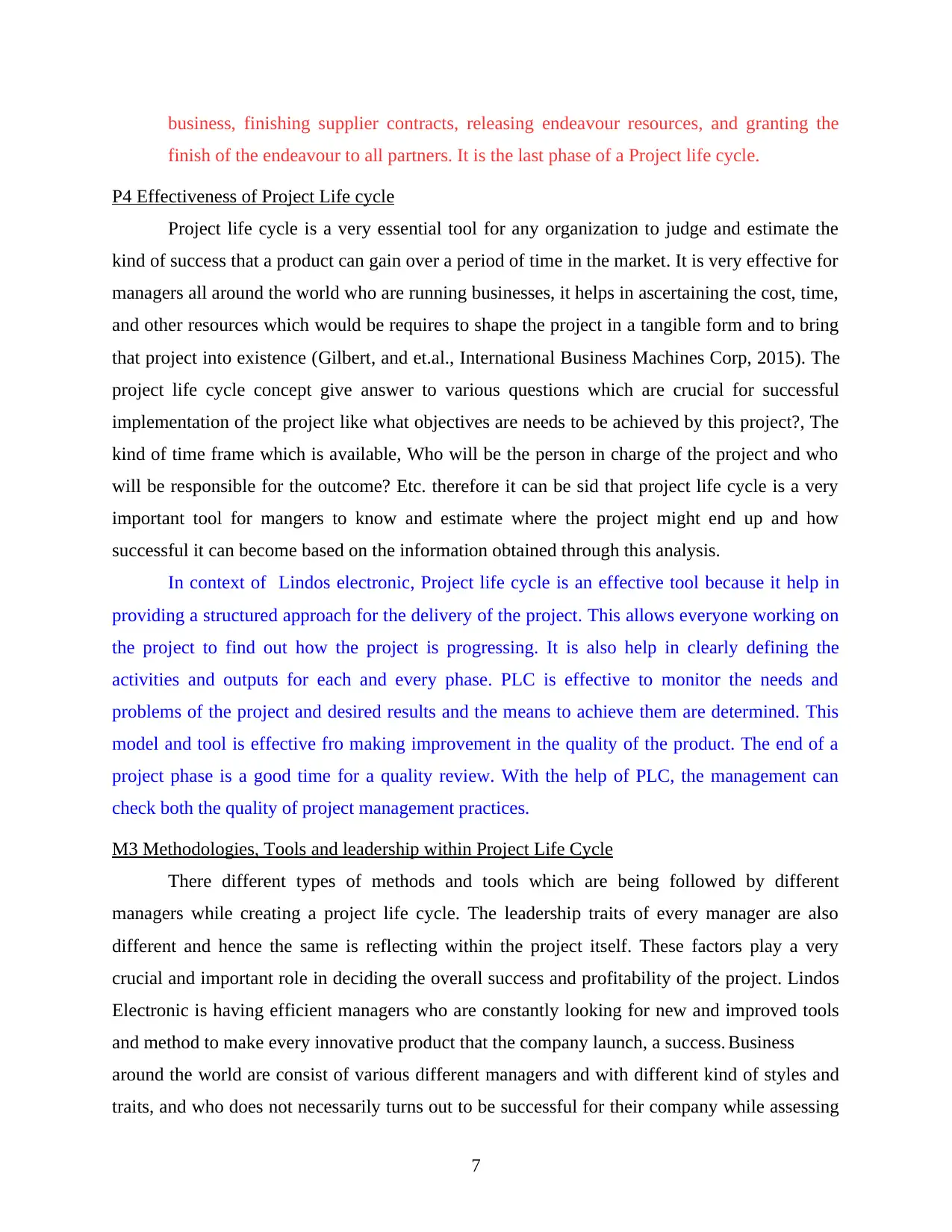
business, finishing supplier contracts, releasing endeavour resources, and granting the
finish of the endeavour to all partners. It is the last phase of a Project life cycle.
P4 Effectiveness of Project Life cycle
Project life cycle is a very essential tool for any organization to judge and estimate the
kind of success that a product can gain over a period of time in the market. It is very effective for
managers all around the world who are running businesses, it helps in ascertaining the cost, time,
and other resources which would be requires to shape the project in a tangible form and to bring
that project into existence (Gilbert, and et.al., International Business Machines Corp, 2015). The
project life cycle concept give answer to various questions which are crucial for successful
implementation of the project like what objectives are needs to be achieved by this project?, The
kind of time frame which is available, Who will be the person in charge of the project and who
will be responsible for the outcome? Etc. therefore it can be sid that project life cycle is a very
important tool for mangers to know and estimate where the project might end up and how
successful it can become based on the information obtained through this analysis.
In context of Lindos electronic, Project life cycle is an effective tool because it help in
providing a structured approach for the delivery of the project. This allows everyone working on
the project to find out how the project is progressing. It is also help in clearly defining the
activities and outputs for each and every phase. PLC is effective to monitor the needs and
problems of the project and desired results and the means to achieve them are determined. This
model and tool is effective fro making improvement in the quality of the product. The end of a
project phase is a good time for a quality review. With the help of PLC, the management can
check both the quality of project management practices.
M3 Methodologies, Tools and leadership within Project Life Cycle
There different types of methods and tools which are being followed by different
managers while creating a project life cycle. The leadership traits of every manager are also
different and hence the same is reflecting within the project itself. These factors play a very
crucial and important role in deciding the overall success and profitability of the project. Lindos
Electronic is having efficient managers who are constantly looking for new and improved tools
and method to make every innovative product that the company launch, a success. Business
around the world are consist of various different managers and with different kind of styles and
traits, and who does not necessarily turns out to be successful for their company while assessing
7
finish of the endeavour to all partners. It is the last phase of a Project life cycle.
P4 Effectiveness of Project Life cycle
Project life cycle is a very essential tool for any organization to judge and estimate the
kind of success that a product can gain over a period of time in the market. It is very effective for
managers all around the world who are running businesses, it helps in ascertaining the cost, time,
and other resources which would be requires to shape the project in a tangible form and to bring
that project into existence (Gilbert, and et.al., International Business Machines Corp, 2015). The
project life cycle concept give answer to various questions which are crucial for successful
implementation of the project like what objectives are needs to be achieved by this project?, The
kind of time frame which is available, Who will be the person in charge of the project and who
will be responsible for the outcome? Etc. therefore it can be sid that project life cycle is a very
important tool for mangers to know and estimate where the project might end up and how
successful it can become based on the information obtained through this analysis.
In context of Lindos electronic, Project life cycle is an effective tool because it help in
providing a structured approach for the delivery of the project. This allows everyone working on
the project to find out how the project is progressing. It is also help in clearly defining the
activities and outputs for each and every phase. PLC is effective to monitor the needs and
problems of the project and desired results and the means to achieve them are determined. This
model and tool is effective fro making improvement in the quality of the product. The end of a
project phase is a good time for a quality review. With the help of PLC, the management can
check both the quality of project management practices.
M3 Methodologies, Tools and leadership within Project Life Cycle
There different types of methods and tools which are being followed by different
managers while creating a project life cycle. The leadership traits of every manager are also
different and hence the same is reflecting within the project itself. These factors play a very
crucial and important role in deciding the overall success and profitability of the project. Lindos
Electronic is having efficient managers who are constantly looking for new and improved tools
and method to make every innovative product that the company launch, a success. Business
around the world are consist of various different managers and with different kind of styles and
traits, and who does not necessarily turns out to be successful for their company while assessing
7
⊘ This is a preview!⊘
Do you want full access?
Subscribe today to unlock all pages.

Trusted by 1+ million students worldwide
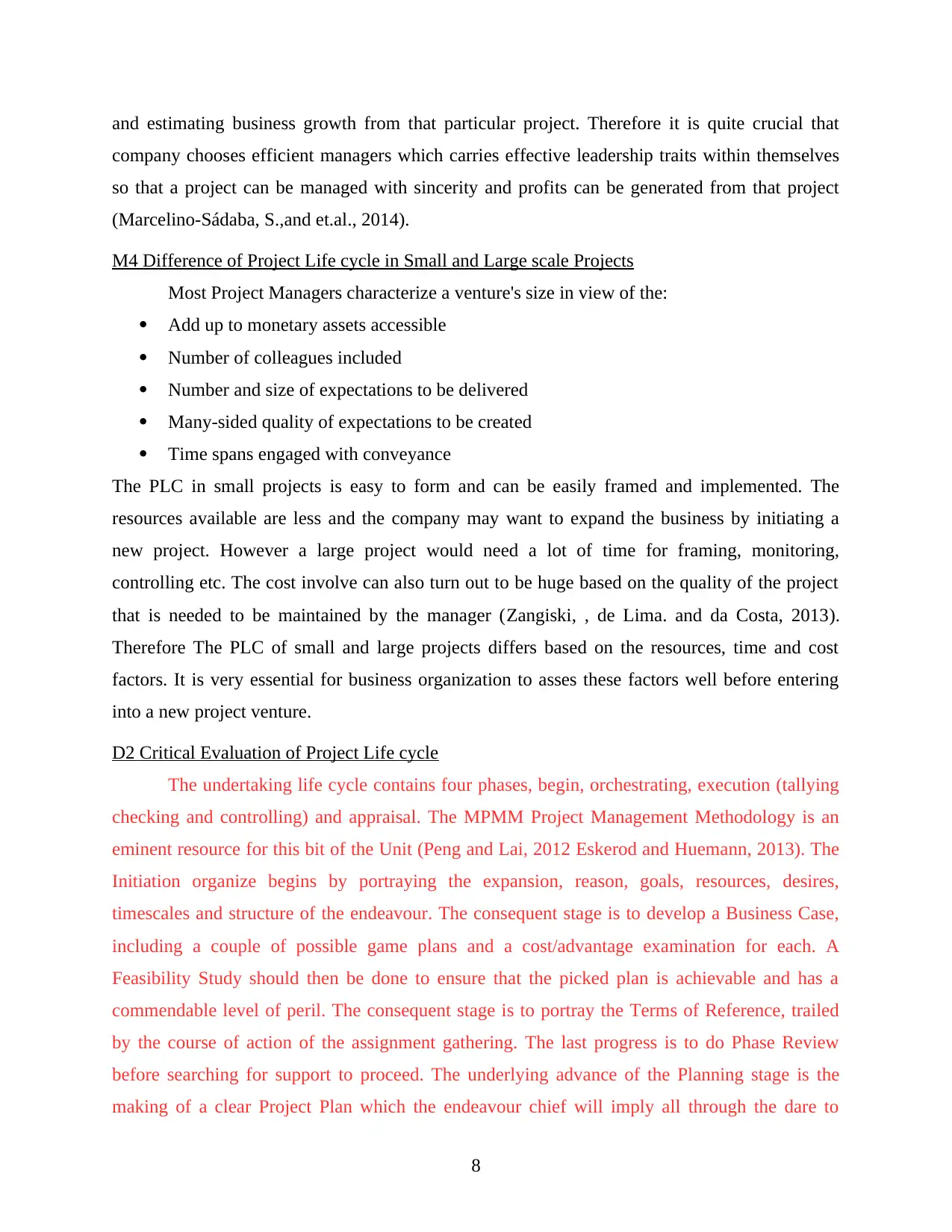
and estimating business growth from that particular project. Therefore it is quite crucial that
company chooses efficient managers which carries effective leadership traits within themselves
so that a project can be managed with sincerity and profits can be generated from that project
(Marcelino-Sádaba, S.,and et.al., 2014).
M4 Difference of Project Life cycle in Small and Large scale Projects
Most Project Managers characterize a venture's size in view of the:
Add up to monetary assets accessible
Number of colleagues included
Number and size of expectations to be delivered
Many-sided quality of expectations to be created
Time spans engaged with conveyance
The PLC in small projects is easy to form and can be easily framed and implemented. The
resources available are less and the company may want to expand the business by initiating a
new project. However a large project would need a lot of time for framing, monitoring,
controlling etc. The cost involve can also turn out to be huge based on the quality of the project
that is needed to be maintained by the manager (Zangiski, , de Lima. and da Costa, 2013).
Therefore The PLC of small and large projects differs based on the resources, time and cost
factors. It is very essential for business organization to asses these factors well before entering
into a new project venture.
D2 Critical Evaluation of Project Life cycle
The undertaking life cycle contains four phases, begin, orchestrating, execution (tallying
checking and controlling) and appraisal. The MPMM Project Management Methodology is an
eminent resource for this bit of the Unit (Peng and Lai, 2012 Eskerod and Huemann, 2013). The
Initiation organize begins by portraying the expansion, reason, goals, resources, desires,
timescales and structure of the endeavour. The consequent stage is to develop a Business Case,
including a couple of possible game plans and a cost/advantage examination for each. A
Feasibility Study should then be done to ensure that the picked plan is achievable and has a
commendable level of peril. The consequent stage is to portray the Terms of Reference, trailed
by the course of action of the assignment gathering. The last progress is to do Phase Review
before searching for support to proceed. The underlying advance of the Planning stage is the
making of a clear Project Plan which the endeavour chief will imply all through the dare to
8
company chooses efficient managers which carries effective leadership traits within themselves
so that a project can be managed with sincerity and profits can be generated from that project
(Marcelino-Sádaba, S.,and et.al., 2014).
M4 Difference of Project Life cycle in Small and Large scale Projects
Most Project Managers characterize a venture's size in view of the:
Add up to monetary assets accessible
Number of colleagues included
Number and size of expectations to be delivered
Many-sided quality of expectations to be created
Time spans engaged with conveyance
The PLC in small projects is easy to form and can be easily framed and implemented. The
resources available are less and the company may want to expand the business by initiating a
new project. However a large project would need a lot of time for framing, monitoring,
controlling etc. The cost involve can also turn out to be huge based on the quality of the project
that is needed to be maintained by the manager (Zangiski, , de Lima. and da Costa, 2013).
Therefore The PLC of small and large projects differs based on the resources, time and cost
factors. It is very essential for business organization to asses these factors well before entering
into a new project venture.
D2 Critical Evaluation of Project Life cycle
The undertaking life cycle contains four phases, begin, orchestrating, execution (tallying
checking and controlling) and appraisal. The MPMM Project Management Methodology is an
eminent resource for this bit of the Unit (Peng and Lai, 2012 Eskerod and Huemann, 2013). The
Initiation organize begins by portraying the expansion, reason, goals, resources, desires,
timescales and structure of the endeavour. The consequent stage is to develop a Business Case,
including a couple of possible game plans and a cost/advantage examination for each. A
Feasibility Study should then be done to ensure that the picked plan is achievable and has a
commendable level of peril. The consequent stage is to portray the Terms of Reference, trailed
by the course of action of the assignment gathering. The last progress is to do Phase Review
before searching for support to proceed. The underlying advance of the Planning stage is the
making of a clear Project Plan which the endeavour chief will imply all through the dare to
8
Paraphrase This Document
Need a fresh take? Get an instant paraphrase of this document with our AI Paraphraser
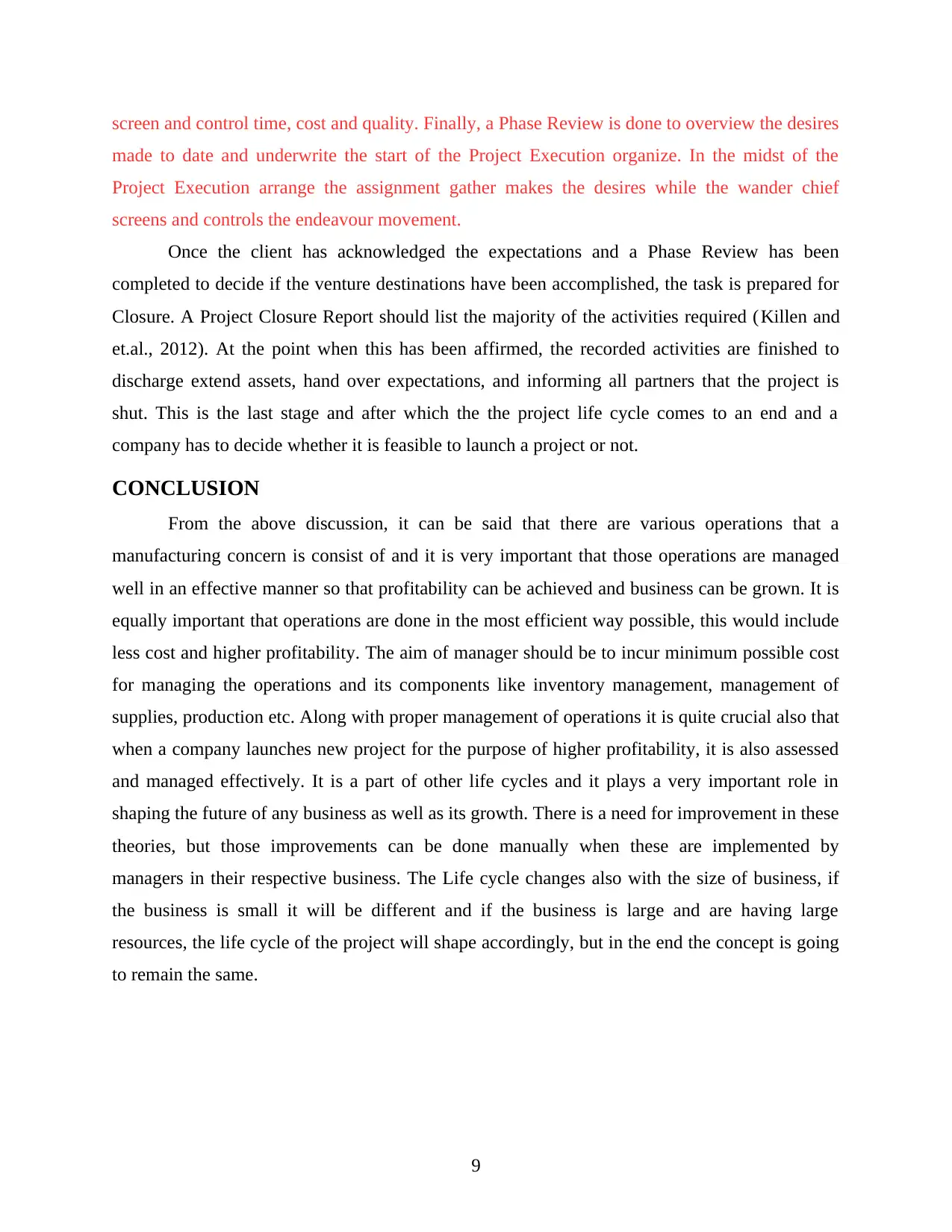
screen and control time, cost and quality. Finally, a Phase Review is done to overview the desires
made to date and underwrite the start of the Project Execution organize. In the midst of the
Project Execution arrange the assignment gather makes the desires while the wander chief
screens and controls the endeavour movement.
Once the client has acknowledged the expectations and a Phase Review has been
completed to decide if the venture destinations have been accomplished, the task is prepared for
Closure. A Project Closure Report should list the majority of the activities required (Killen and
et.al., 2012). At the point when this has been affirmed, the recorded activities are finished to
discharge extend assets, hand over expectations, and informing all partners that the project is
shut. This is the last stage and after which the the project life cycle comes to an end and a
company has to decide whether it is feasible to launch a project or not.
CONCLUSION
From the above discussion, it can be said that there are various operations that a
manufacturing concern is consist of and it is very important that those operations are managed
well in an effective manner so that profitability can be achieved and business can be grown. It is
equally important that operations are done in the most efficient way possible, this would include
less cost and higher profitability. The aim of manager should be to incur minimum possible cost
for managing the operations and its components like inventory management, management of
supplies, production etc. Along with proper management of operations it is quite crucial also that
when a company launches new project for the purpose of higher profitability, it is also assessed
and managed effectively. It is a part of other life cycles and it plays a very important role in
shaping the future of any business as well as its growth. There is a need for improvement in these
theories, but those improvements can be done manually when these are implemented by
managers in their respective business. The Life cycle changes also with the size of business, if
the business is small it will be different and if the business is large and are having large
resources, the life cycle of the project will shape accordingly, but in the end the concept is going
to remain the same.
9
made to date and underwrite the start of the Project Execution organize. In the midst of the
Project Execution arrange the assignment gather makes the desires while the wander chief
screens and controls the endeavour movement.
Once the client has acknowledged the expectations and a Phase Review has been
completed to decide if the venture destinations have been accomplished, the task is prepared for
Closure. A Project Closure Report should list the majority of the activities required (Killen and
et.al., 2012). At the point when this has been affirmed, the recorded activities are finished to
discharge extend assets, hand over expectations, and informing all partners that the project is
shut. This is the last stage and after which the the project life cycle comes to an end and a
company has to decide whether it is feasible to launch a project or not.
CONCLUSION
From the above discussion, it can be said that there are various operations that a
manufacturing concern is consist of and it is very important that those operations are managed
well in an effective manner so that profitability can be achieved and business can be grown. It is
equally important that operations are done in the most efficient way possible, this would include
less cost and higher profitability. The aim of manager should be to incur minimum possible cost
for managing the operations and its components like inventory management, management of
supplies, production etc. Along with proper management of operations it is quite crucial also that
when a company launches new project for the purpose of higher profitability, it is also assessed
and managed effectively. It is a part of other life cycles and it plays a very important role in
shaping the future of any business as well as its growth. There is a need for improvement in these
theories, but those improvements can be done manually when these are implemented by
managers in their respective business. The Life cycle changes also with the size of business, if
the business is small it will be different and if the business is large and are having large
resources, the life cycle of the project will shape accordingly, but in the end the concept is going
to remain the same.
9
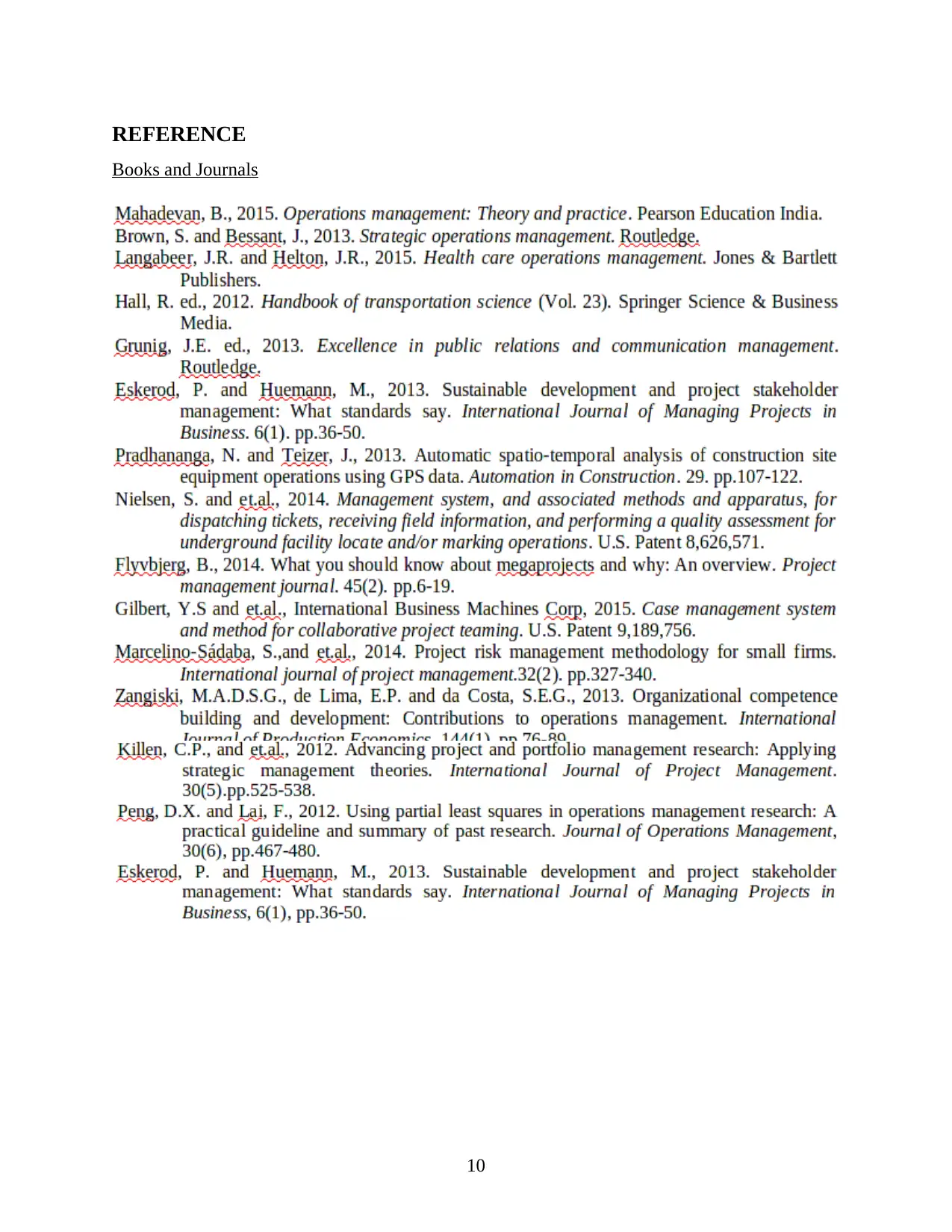
REFERENCE
Books and Journals
10
Books and Journals
10
⊘ This is a preview!⊘
Do you want full access?
Subscribe today to unlock all pages.

Trusted by 1+ million students worldwide
1 out of 12
Related Documents
Your All-in-One AI-Powered Toolkit for Academic Success.
+13062052269
info@desklib.com
Available 24*7 on WhatsApp / Email
![[object Object]](/_next/static/media/star-bottom.7253800d.svg)
Unlock your academic potential
Copyright © 2020–2025 A2Z Services. All Rights Reserved. Developed and managed by ZUCOL.





